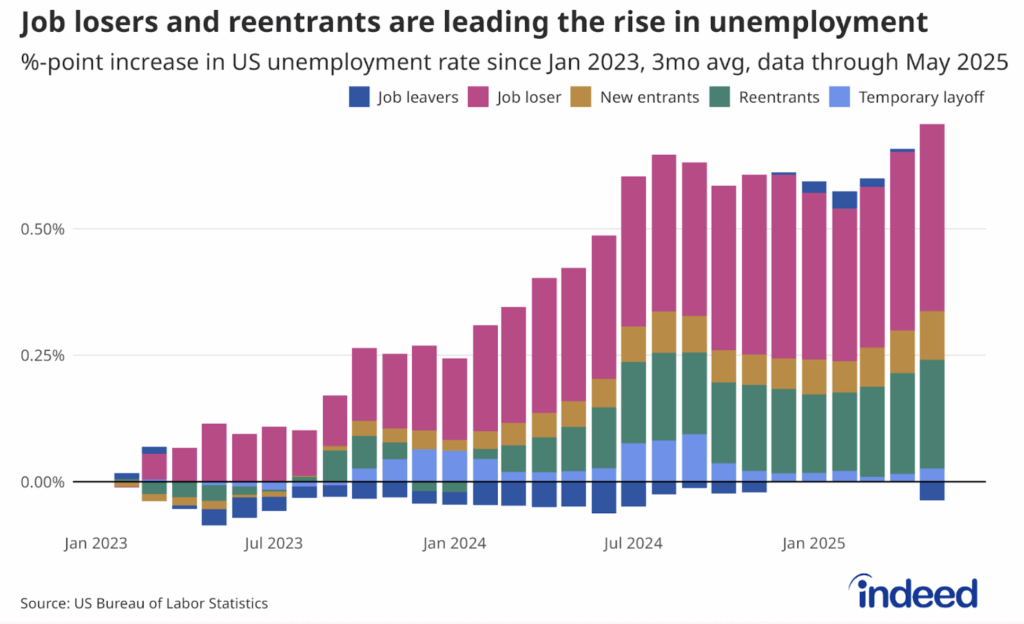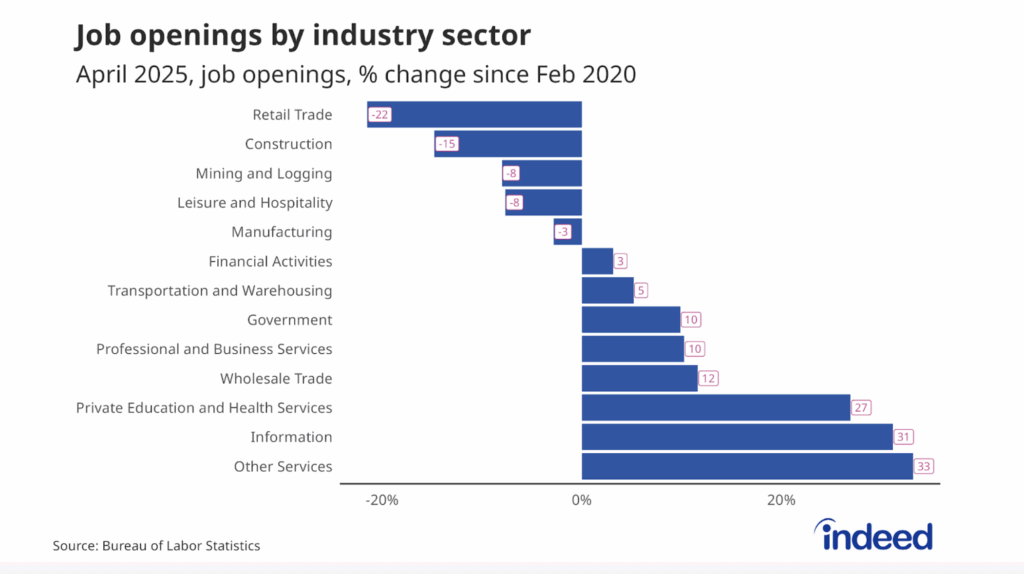Key Points
- Active job search dropped from a month earlier among respondents in the August 2021 Indeed Hiring Lab Job Search Survey.
- The decline was entirely concentrated among employed respondents, whose share actively searching dropped five percentage points.
- An increase in job search is expected in the fall as more children return to school despite the ongoing threat from the COVID-19 Delta variant.
Job search in the US receded in August from a month earlier, according to the latest edition of the Indeed Hiring Lab Job Search Survey.
The Indeed Hiring Lab polled 5,000 people in the US in mid-August, ages 18-64. The surveys have been conducted monthly since late May. The samples include individuals in and out of the labor force, and employed and jobless people.
The August survey found 27.9% of respondents actively looking for paid employment, down from 31.6% in July, but up from 24.4% in June. Almost all of this fluctuation has been among people who already have jobs. Active search among the jobless has been more-or-less consistent.
One notable change was that unemployed people were significantly more likely to cite the return of in-person school as a key milestone for starting a new job. Perhaps that’s because, with school starting or about to start, the potential relief from in-person schooling was top of mind for many respondents.
These survey results suggest an increase in job search may occur in the fall as more children return to school. Nevertheless, the threat from the COVID-19 Delta variant remains. Continued spread of coronavirus may directly reduce search by intensifying job searcher fears. It could also have indirect effects by slowing the return of in-person schooling or curbing job growth. We’ll keep an eye on this trend and others in the months ahead.
Job search slows, but only among the employed
The August drop in active job search was roughly equally divided among those who were searching urgently and those who weren’t. The rate of active job search was still higher than in our June survey, but the increase has not been steady.
Almost all the fluctuation in active job search has come from employed respondents. Among those who already had a job, 21.1% were actively searching for work in our June survey. That share rose to 31.4% in July and then ticked down to 26.6% in August.
By contrast, the share of jobless respondents actively looking for work fluctuated slightly in the past three months, but the variation was not statistically significant.
The national rise in employment between the surveys can’t explain the drop in active job search. If the share of the population with a job stayed the same, then the share of the overall population actively searching would have dropped by almost the same percentage as it did with a rising employment rate.
More unemployed workers want to start a job once school starts
Timing preferences for starting a new job changed little from July. Some 65.7% of active job seekers wanted to start a job immediately in August, statistically indistinguishable from the July rate. However, the increase from the 64.4% rate in the June survey is statistically significant.
Bar chart titled “Timing preferences for starting a new job.” With a vertical axis ranging from 0% to 70%, Indeed compared the percentage of active job seekers saying when they would like to start a new job between “immediately,” “within the next 1 to 3 months,” and “within 4 to 12 months” with different colored bars representing June, July, and August 2021. As of August 18, 2021, 65.7% of active job seekers wanted to start a job immediately.
Unemployed workers who weren’t searching urgently cited COVID fears, employed partners, and financial cushions as top reasons for their lack of haste. These factors didn’t shift in a statistically significant way from a month earlier.
The lack of change might be surprising given the surge in coronavirus due to the Delta variant. Increased vaccination rates among unemployed people not searching urgently may explain the similar results. The share of this group who said they were fully vaccinated rose to 49% in August from 37% in July. Fears of COVID-19 were less commonly cited by the non-urgent unemployed who were fully vaccinated compared with those who were not vaccinated, but the difference was not statistically significant.
One noticeable change was that unemployed people were much more likely to point to the return of in-person schooling as an important milestone for starting a new job. This might be because school reopening is on many respondents’ minds with the school year about to start. However, the Delta variant could pose a risk to a smooth transition back to in-person learning.
financial cushions were the top reasons given by unemployed workers not searching urgently for a job.
Conclusion: No sustained pickup yet
A steady pickup in US job search hasn’t shown up in the Indeed Hiring Lab Job Search Survey yet. The fall, with the return of schools, holds the possibility of a renewed upward trajectory. But the Delta variant and the continued spread of COVID-19 might hinder any gains. On the plus side, increased vaccination may reduce COVID-19’s chilling effect on job search. The bottom line? The near-term future is uncertain, but the fall might offer some relief.
Methodology
This blog post is based on three online surveys of 5,000 US adults ages 18-64. The first survey was conducted May 26-June 3, the second July 12-20, and the most recent August 10-18. Weights were applied to each survey to match respondent distributions across age, educational attainment, race/ethnicity, and sex with the 2020 Current Population Survey’s Annual Social and Economic Supplement.
Statistically significant differences between the surveys depend upon the exact question and the specific survey wave. For example, between the July and August surveys, a difference of at least 1.3 percentage points is required for a change in the share of the population that is actively and urgently searching to be statistically significant at the 5% level. For a change in the share of active job seekers who want to start a job immediately to be significant at the same level over the same time period, it would have to be at least 3.6 percentage points. A change in the share of unemployed not urgently searching citing COVID-19 fears would have to be at least 7.7 points.






